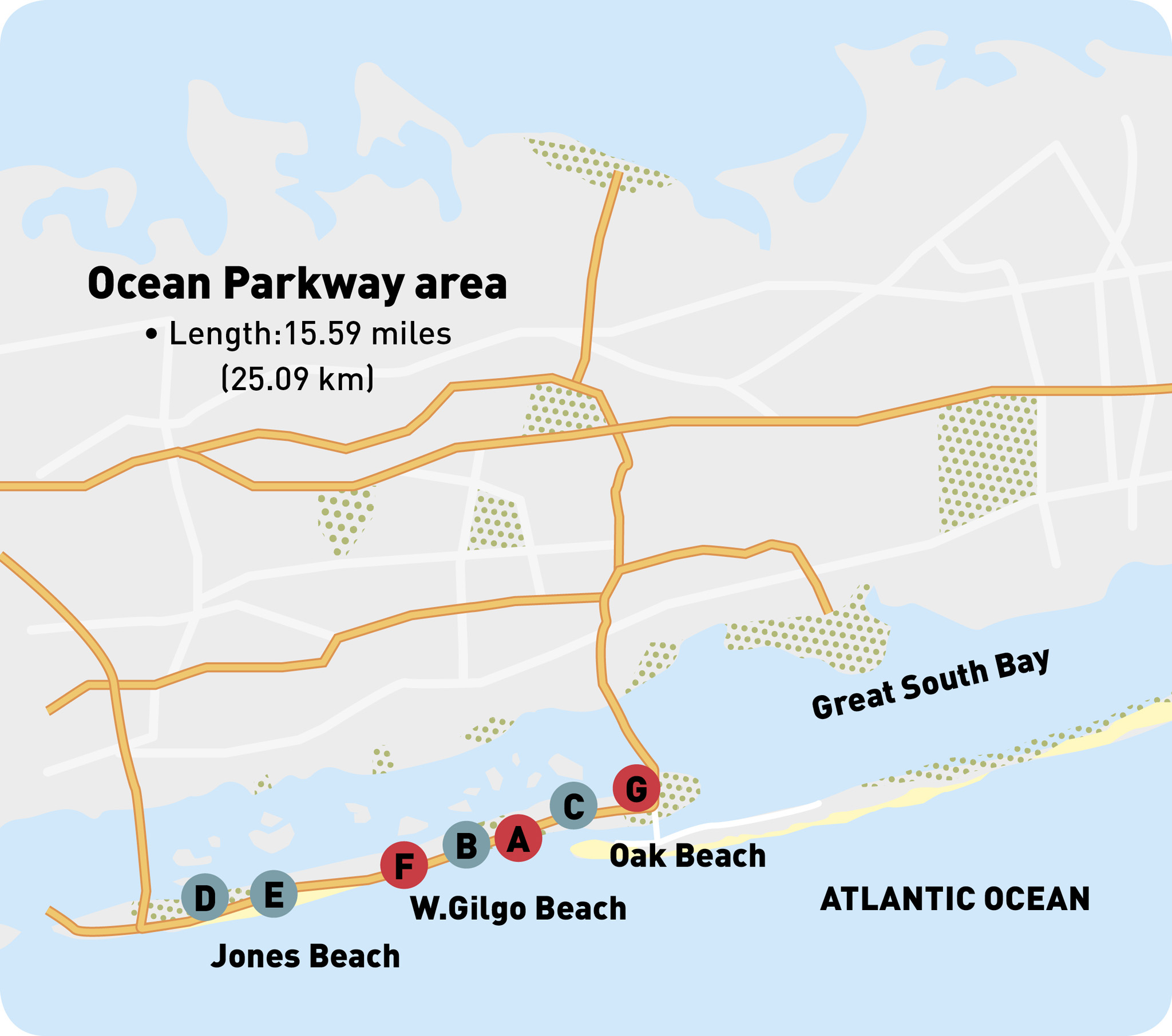LONG ISLAND SERIAL KILLER, c.1996–2010
LOST IN THE MARSHLAND
The woman was terrified, seemingly running for her life. Soon after she vanished into the night, a peaceful area of rural Long Island began to yield up its terrible secrets.
Dense marshland runs alongside Long Island’s Ocean Parkway, a beautiful—albeit desolate—stretch of beach highway. It was here, hidden away from the eyes of passing drivers, that a serial killer disposed of his victims. Over the course of almost 20 years, the Long Island Serial Killer—or the Gilgo Beach Killer, as he was also known—murdered between 10 and 16 people associated with prostitution. The identity of the killer and his motives have perplexed homicide detectives ever since the first discovery of his victims in December 2010, and has led to one of the most infamous, unidentified serial-killer cases in recent history.
This grim story unfolded on May 1 of that year, when Shannan Gilbert, a 24-year-old Craigslist escort from New Jersey, vanished. Before her disappearance, Shannan had visited the home of Joseph Brewer, a resident of the upmarket gated community of Oak Beach, who had hired Shannan as his escort for the evening. Brewer would later tell police that, after arriving at his home, Shannan began to act erratically and appeared disoriented before fleeing out into the warm night. She ran straight past her pimp, Michael Pak, who was waiting for her outside in his black Ford Explorer. Several neighbors saw—and heard—Shannan that night. She ran down the street of expensive houses, pounding on doors and screaming for help. Despite her evident distress, nobody let her in. Instead, they called 911 and watched as she ran away from the Oak Beach gatehouse toward Anchor Way and then onto the bayou, completely out of sight. Exactly who Shannan was running from remains a mystery. At some point during her escape, she managed to call 911 and hollered “They’re trying to kill me!”1

Main image: Joseph Brewer’s house, which Shannan Gilbert fled from
Clockwise from top: Police search Jones Beach in April 2011; Ocean Parkway where the killer dumped the bodies; suspect Joel Rifkin; memorial for Melissa Barthelemy; newspaper articles covering the discovery of the bodies.
THE LOST WOMEN
Seven months after Shannan disappeared, four bodies were found close to one another, nestled among the thorny underbrush running alongside Ocean Parkway on Gilgo Beach. As news of this gruesome find circulated in the media, locals and investigators presumed that one of the bodies would be Shannan Gilbert, as the site was just 3 miles (4.8 km) from where she was last seen. However, an examination of the remains concluded that none of them was her. They were identified as Amber Lynn Costello, 27; Melissa Barthelemy, 24; Maureen Brainard-Barnes, 25; and Megan Waterman, 22. Just like Shannan, all four women had been working as Craigslist escorts when they disappeared. Maureen went missing in July 2007 when she left Norwich, Connecticut for New York City; Melissa vanished in July 2009 after meeting with an escort client; Megan disappeared just a month after Gilbert, having placed a Craigslist advertisement; and Amber vanished in September 2010, after arranging to meet a client who offered her $1,500 for her services.
It became clear that these discoveries had unearthed a serial killer’s dumping ground and, in April 2011, an extensive search was finally launched. Airplanes fitted with high-tech photographic equipment scoured the area, while police with horses and dogs explored the undergrowth alongside the highway and beach. The search led to the discovery of six more victims approximately 1 mile (1.6 km) east of the other bodies: four more women, a female toddler and an Asian man wearing women’s clothing. Of these victims—which were all found within 2 miles (3.2 km) of the first cluster of bodies—only one has ever been identified: 20-year-old Jessica Taylor. She vanished in July 2003, while working as an escort in Manhattan, New York. Shortly after her disappearance, her dismembered torso had been found in Manorville, New York, around 40 miles (64.4 km) east of Gilgo Beach. Her skull, hands, and a forearm were subsequently discovered during the search of Gilgo Beach itself. The remains of another victim, known only as “Jane Doe No. 6,” were also found at Manorville and Gilgo Beach. While the police were unable to identify the remains, forensic experts did determine that none belonged to Shannan Gilbert.
WHAT HAPPENED TO SHANNAN?
In early December 2011, an extended search turned up Shannan Gilbert’s purse, cell phone, lip gloss, jeans, and shoes in a marsh near Oak Beach, several miles to the east of the second group of bodies. Following the discovery, the search for Shannan intensified, with the outcome looking decidedly bleak. Dozens of officers using machetes and a bulldozer were called to the scene.
December 13, 2011 / The remains of Shannan Gilbert are found in a shallow marsh near Oak Beach, the place where she was last seen alive.
The authorities soon announced that they believed Gilbert had drowned in the marsh and that her death was not connected to the other murders, despite the fact that she was found in the same vicinity and fit the victim profile. Her family was furious with this conclusion and lambasted this “premature and inconsiderate” theory.2 In fact, before Gilbert’s body was even found, Suffolk County Police Commissioner Richard Dormer publicly announced that he believed Gilbert had wandered off and accidentally drowned. “I think Dormer just wants to find the remains, say she drowned, and close the case before he retires,” fumed Mari Gilbert, Shannan’s mother.
The investigation also drew criticism from some of the victims’ families, who accused officers of incompetence and inaction. Some even hired their own private investigators. Shannan’s family hired Michael Baden, a forensic pathologist, in order to obtain a second opinion on her autopsy. According to Baden, there was no evidence that Shannan had died of natural causes, a drug overdose, or, as Suffolk County Police believed, by drowning. He observed that there was insufficient information to determine a definite cause of death, but found that the hyoid bone in Shannon’s neck was deformed, which could have been caused by strangulation.3
“THESE STRUCTURES, THE LARYNX AND THE HYOID BONE, ARE OFTEN FRACTURED DURING HOMICIDAL MANUAL STRANGULATION.”
MICHAEL BADEN
Since the discovery of the bodies, plenty of theories have abounded. Some have speculated that the killer was a seasonal worker, a drifter, or a fisherman from Freeport. More lurid theories have also been put forward—that the killer was making snuff films or belonged to a satanic cult. Another hypothesis involved a local businessman who committed suicide days after Shannan’s remains were found. Police were quick to deny that he was a suspect; he was merely a victim of rumors and hearsay.
UNTRACEABLE CALLS
One of the more likely theories was that the killer was a police officer—or ex-police officer—with extensive knowledge of law enforcement techniques. Following Melissa Barthelemy’s disappearance, the Long Island Serial Killer made taunting phone calls to her 16-year-old sister, Amanda. He called Melissa a whore and asked if Amanda knew what Melissa was doing. These calls were always placed from crowded areas such as New York’s Penn Station and Madison Square Garden, where it would have been next to impossible for surveillance cameras to single out the caller from the crowd. Moreover, the caller only stayed on the line for under three minutes, indicating that he knew it took from three to five minutes to successfully trace a phone call. Police were convinced that these calls came from the killer, as opposed to a prankster, leading many to believe that the murderer must have been a member of a law enforcement agency at some point in his life.
Amid the investigation into the murders, Suffolk County Police Chief James Burke resigned, adding fuel to the rogue cop theory. Following his resignation, Burke was arrested for a 2012 assault on Christopher Loeb, who had stolen a duffel bag filled with pornography and sex toys from Burke’s car. After Burke’s arrest, an escort came forward to claim that he was into “rough sex.” She alleged that Burke had attempted to strangle her during a party in Oak Beach, the gated community where Gilbert was last seen alive. It then transpired that Burke had stymied an FBI investigation into the Long Island murders and had intentionally kept them out of the loop. What was he afraid of the FBI finding? In 2016, an attorney for Shannan Gilbert’s family alleged that there could be a connection between Burke and the murders; however, he was never charged.
THE LYING DOCTOR
Another suspect in the slayings was Dr. Peter Hackett, a physician and neighbor of Joseph Brewer (one of the last people to see Shannan alive). Dr. Hackett lived in close proximity to the marshland where Shannan Gilbert’s remains would later be found. According to Shannan’s mother, Mari Gilbert, Dr. Hackett had called her the day after her daughter went missing and told her that he was a doctor who “ran a home for wayward girls.” Several days later, Dr. Hackett denied he had ever made this call. Phone records, however, confirmed that he had called Mari Gilbert twice following Shannan’s disappearance.
In 2012, Shannan’s family filed a wrongful death lawsuit against Dr. Hackett, in which they alleged that he could have prevented her death. “Dr. Hackett told Mari Gilbert that he ran a home for wayward girls, and that Shannan was in his care,” said John Ray, an attorney for the Gilbert family. “Why would anyone do something like that?”4 Dr. Hackett was eventually ruled out as a suspect by Suffolk County Police. Joseph Brewer also fell under a cloud of suspicion, since Shannan was last spotted fleeing from his home in a state of panic. However, he, too, was quickly ruled out as a suspect when Suffolk County Police could find no evidence to tie him to any of the murders.
INVESTIGATOR THEORIES
For years, law enforcement remained tight-lipped on the notorious Long Island Serial Killer, but in 2017, the silence was at last broken. Suffolk County Assistant District Attorney Robert Biancavilla named a new suspect: John Bittrolff, a carpenter who had recently been charged with two 25-years-to-life sentences for beating two sex workers to death in 1993 and 1994. Bittrolff lived in the hamlet of Manorville, where the torsos of two of the Long Island Serial Killer’s victims were discovered. Biancavilla alleged that some aspects of the evidence found over the years at Ocean Parkway were similar to the earlier crimes attributed to Bittrolff. Evidence found at the crime scenes, however, did not match any found at earlier crime scenes; it was thus impossible to conclusively link Bittrolff to the murders.
A hypothetical profile of the killer was created by Jim Clemente, a criminal profiler; Scott Bonn, an assistant professor of sociology at Drew University; and former Nassau County Assistant District Attorney Fred Klein. They deduced that the killer was likely a white male in his mid-20s to mid-40s; he was married or had a girlfriend; he was intelligent and articulate; he had a decent job that gave him access to burlap sacks and he lived—or once lived—near Ocean Parkway.
A final suspect for at least some of the murders attributed to the Long Island Killer is convicted serial killer Joel Rifkin. Between the years of 1989 and 1993, he murdered at least nine women in New York and Long Island, disposing some of their bodies in the same general area as the Long Island Serial Killer. However, in an interview, Rifkin denied that any of the victims were his. He stated that he dumped his victims “hundreds of miles apart” and not in the same location—something he called the Long Island Serial Killer “sloppy” for doing.5
TELLING THE STORY
On that fateful night of May 1, 2010, Shannan Gilbert drove past the remote marshland where 10 victims of the Long Island Serial Killer lay while en route to an escort call. Unknown to her at the time, the disturbing and mysterious events that would unfold over the forthcoming hours would forever link her to those bodies and spark one of the most extensive murder investigations in Long Island history. Numerous newspapers and magazines; a best-selling book, Lost Girls: An Unsolved American Mystery by Robert Kolker;6 and an episode in the television documentary series The Killing Season have all told the story of the 10 bodies discovered along the Ocean Parkway. Despite the extensive media coverage, the case still remains unsolved and open.
REMAINS FOUND
 Jessica Taylor’s skull, hands, forearms
Jessica Taylor’s skull, hands, forearms
 Asian male
Asian male
 Unidentified child remains, Jane Doe No. 6 remains
Unidentified child remains, Jane Doe No. 6 remains
 Unidentified human bones
Unidentified human bones
 Unidentified skull
Unidentified skull
 Amber Lynn Costello, Melissa Barthelemy, Maureen Brainard-Barnes, Megan Waterman
Amber Lynn Costello, Melissa Barthelemy, Maureen Brainard-Barnes, Megan Waterman
 Shannan Gilbert
Shannan Gilbert
CASE NOTES


 Jessica Taylor’s skull, hands, forearms
Jessica Taylor’s skull, hands, forearms Asian male
Asian male Unidentified child remains, Jane Doe No. 6 remains
Unidentified child remains, Jane Doe No. 6 remains Unidentified human bones
Unidentified human bones Unidentified skull
Unidentified skull Amber Lynn Costello, Melissa Barthelemy, Maureen Brainard-Barnes, Megan Waterman
Amber Lynn Costello, Melissa Barthelemy, Maureen Brainard-Barnes, Megan Waterman Shannan Gilbert
Shannan Gilbert